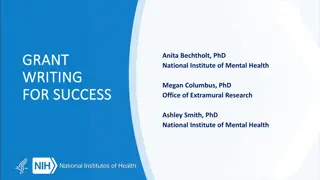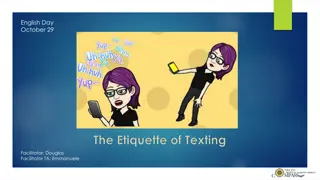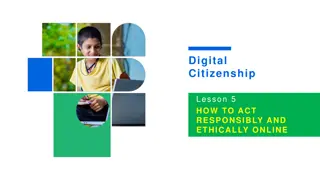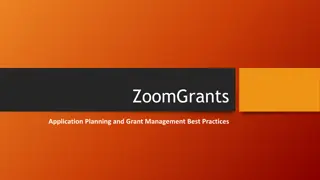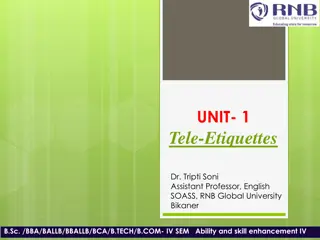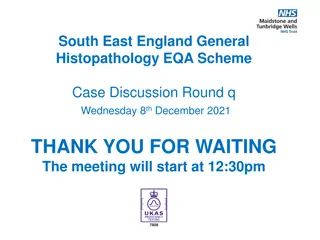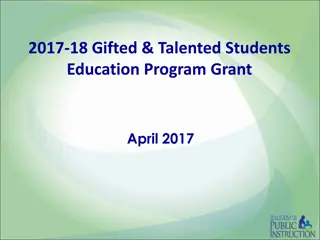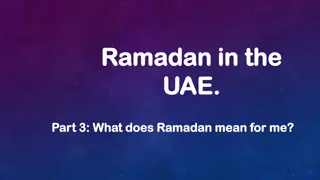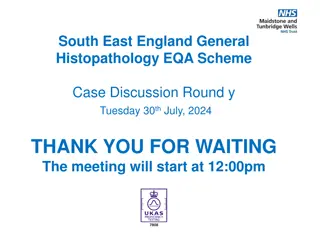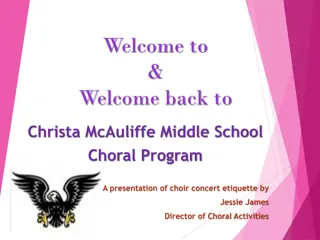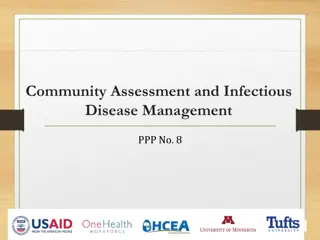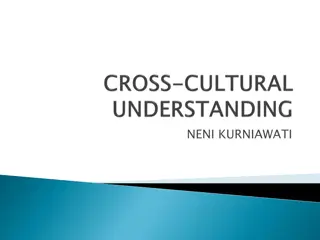Meeting Etiquette and Grant Activities Overview
Final report guide detailing meeting etiquette, grant activities, evaluation methods, and support materials for Department of State Division of Arts and Culture grants impact assessment.
Download Presentation

Please find below an Image/Link to download the presentation.
The content on the website is provided AS IS for your information and personal use only. It may not be sold, licensed, or shared on other websites without obtaining consent from the author.If you encounter any issues during the download, it is possible that the publisher has removed the file from their server.
You are allowed to download the files provided on this website for personal or commercial use, subject to the condition that they are used lawfully. All files are the property of their respective owners.
The content on the website is provided AS IS for your information and personal use only. It may not be sold, licensed, or shared on other websites without obtaining consent from the author.
E N D
Presentation Transcript
Meeting Etiquette Participants will be muted Video is disabled Chat feature is available Q&A will take place at the end TYPEHERE
GRANT ACTIVITIES Detail the title, location, and description of grant activities, including objectives and methods. This can be a list with the objectives and methods from your application updated to reflect what you did Make sure to refer back to your application EXAMPLE Activities: SwampDoc Conversations - September 22, 2023, O Cinema South Beach. Explores sustainable issues affecting the Southeast Region of the US. Features a pitch session segment for projects that need assistance/guidance. Fulfills Objectives 1, 3 & 5 from the application.
GRANT DETAILS Evaluation Describe how the evaluation was conducted Describe the methods used to collect participant feedback Describe when the evaluation took place during or after the activity Describe the findings Describe how the findings will be used in future activities
SUPPORT MATERIALS Credits Department of State Division of Arts and Culture This should show the Division s new logo Uses appropriate accessibility symbols to show that the facility and programming are accessible Accessibility symbols include: File formats: Images: .jpg, .gif, .png or .tiff Documents: .doc, docx, .pdf or .txt Audio: .mp3 Video: .mp4, .mov, or .wmv MAX 5 MB MAX 10 MB MAX 10 MB MAX 200 MB
GRANT IMPACT 1. How many actual events were part of this grant? Only list events within the grant period. Do not duplicate events. a musical performed 10 times is only ONE event; a workshop presented one time is ONE event. 2. How many opportunities for public participation were part of this grant? Each event has a minimum of one opportunity. This allows you to account for multiple instances of the same event a musical performed 10 times is ONE event with 10 OPPORTUNITIES for public participation.
GRANT IMPACT 3. How many total individuals benefited? This should equal the total number of people in boxes a through e. Do not count individuals reached through TV, radio, cable broadcast, the Internet, or other media. Do not double-count repeat attendees. 3a. How many Adults were engaged? Individuals 18-64 3b. How many school based youth benefited? Under the age of 18 attending through their school 3c. How many non-school based youth benefited? Under the age of 18 attending outside their school
GRANT IMPACT 3d. How many older adults benefited? Individuals over the age of 65 3e. How many artists were directly involved? Professional artists providing artistic services for grant activities LIVING artists whose work is represented in an exhibition List TOTAL number of artists involved 3f. How many Florida Artists were directly involved? List FLORIDA artists involved (this number cannot be greater than the TOTAL number of artists listed above)
GRANT IMPACT 4. Population Benefited by Age. Made up 25% or more of the population directly benefited, excluding broadcasts or online programming. You should not click No single group made up more than 25% of the population directly benefited. 5. Population Benefited by Distinct Groups. Made up 25% or more of the population directly benefited, excluding broadcasts or online programming. Here, you can click that no distinct group made more than 25% because not all your attendees will fall into one of these categories.
IMPACT - ENGAGEMENT 6. Number of staff currently employed? 7. How many new staff positions or outside contractors were added during the grant period? 8. Where did the project/Program actually take place? Select the counties in which the project/programming actually occurred. For example, if your organization is in Alachua county and you completed programming that took place in Alachua and the surrounding counties of Clay and St. Johns, you will list all three counties. 9. What counties does your organization serve? Select the counties in which your organization provides services. For example, if your organization is located in Alachua County and you provide resources and services in Alachua as well as the surrounding counties of Clay and St. Johns, you will list all three counties. This might include groups that visit your facility from other counties.
IMPACT - ENGAGEMENT 10. How many opportunities were provided for virtual public participation? How many different events were produced or presented virtually within the grant period as part of this grant? Each event counts as one opportunity for virtual programming 11. How many individuals participated in virtual interactions with your organization? This includes virtual visits to virtual galleries, online exhibits, production videos, etc. It does not include those reached through advertising.
NEA Descriptors Project Discipline This should reflect the discipline you applied through. Type of Activity Look through the list carefully and pick the best match Primary Strategic Outcome Five options: Creation, Engagement, Learning, Livability, or Understanding. Can only pick one
NEA Descriptors Arts in Education 50% or More generally means you applied in Arts and Education category Less than 50% None Population Benefited by Race/Ethnicity Does not have to be an exact number. We encourage your best guess. Location of Project Activity Actual address If there is no address, use GPS coordinates
GRANT BUDGET 1. Budget at a Glance This will reflect what you enter. You cannot change these numbers. 2. Actual Budget Expenses This will auto-populate with your grant budget. If you ve filed an amendment, it will populate with that updated budget. Update this section to reflect your actual budget Grant expenditure for each budget category cannot be more than +/- 20% different from your contract budget. If you are off by more than the 20% for cash match, enter a note in Box 5 at the bottom to explain.
GRANT BUDGET 3. Actual Budget Income State and federal funds are not allowed in the Actual Budget Income. This includes any income that comes from an appropriation or grant from the State of Florida. If you received income in excess of Actual Expenses, you must enter how this will be used in Box 4. Expenditure Log Will take you to your expenditure log Complete all columns To delete a row, make sure all fields are blank. Must match grant funds in Actual Budget Expenses
Expenditure Log Use the entry boxes to provide the following information: o Invoice Add the invoice number o Transaction Number Unique number of transaction in your accounting system or financial institution. Example - Check 2058, EFT 289, or Debit 7338. NOTE: You MUST have either an Invoice or Transaction number, but do not need both. o Payment Date The date of transaction MM/DD/YYYY format. o Payee The name of the person or organization to whom money is paid (this should not be your organization).
Expenditure Log o Transaction Total TOTAL amount of transaction. o Grant Funds PORTION of transaction attributed to grant funds. Must be less than or equal to the Transaction Total. o Cash Match/In-Kind Leave blank o Deliverable Choose Deliverable that corresponds to the expenditure. o Budget Category Select the budget category that corresponds to this transaction. NOTE: You may only expend grant funds in the budget categories/line items that included grant funds in the contract budget. Check Contract Details if unsure. o Description Provide a BRIEF description of the expenditure.
FLORIDA SINGLE AUDIT ACT Florida Single Audit Act - requires recipients/sub-recipients to have state single audit if $750,000 or more in state financial assistance is expended during the non-state entity s fiscal year. (Section 215.97, F.S., Florida Single Audit Act ) Federal Single Audit Act requires recipients/sub-recipients to have single audit if $750,000 or more in federal financial assistance is expended during the non-state entity s fiscal year Applies to non-state entities* (see F.S. 215.97 (n)) Before checking this box, check your organization Details page and click the tab for the Single Audit Act.
GRANTEE INFORMATION Verify that your information is correct. If it is not, update it in your Organization Profile page Grant Contact Make sure that the current person is listed This is who we will contact if there are any issues with the final report Certify and Submit Due JULY 30th If you are late, you will be placed in non-compliance the next day.
GRANT RESOURCES General Information Managing Your Grants Online Grant System DOS Grants FAQ Division of Arts and Culture Calendar
GRANT PROGRAM MANAGERS Samantha Arroyo Sam Brown Samantha.Arroyo@dos.fl.gov Samuel.Brown@dos.fl.gov Cultural Endowments Multidisciplinary Cultural Facilities Adrianne Morrison Hogan Sue Ernst Adrianne.Hogan@dos.fl.gov Susan.Ernst@dos.fl.gov Arts in Education Dance Presenter Visual Arts Media Arts Paul Gabbard Cassandra White Paul.Gabbard@dos.fl.gov Community Theatre Cassandra.White@dos.fl.gov Professional Theatre Music Patricia Singletary Jennifer Goudeau Patricia.Singletary@dos.fl.gov Jennifer.Goudeau@dos.fl.gov Museums Underserved Literature Artist Projects LAA/SSO Traditional Arts
7 QUESTION S ANSWERS TYPE HERE Links for the presentation and materials will be posted on Managing Your Grants Section of the DAC Website.









